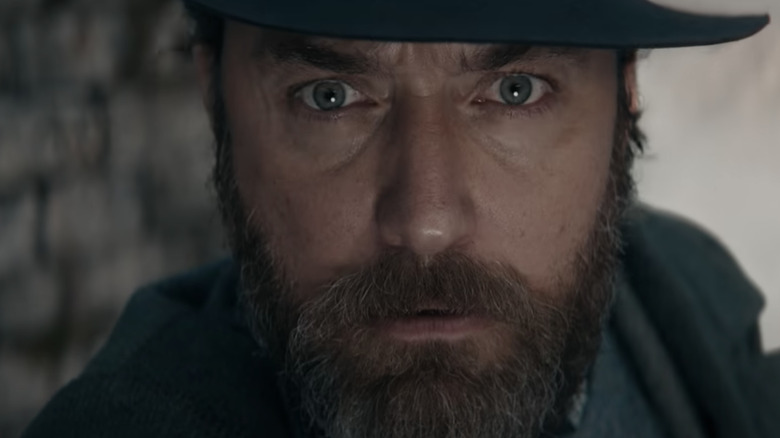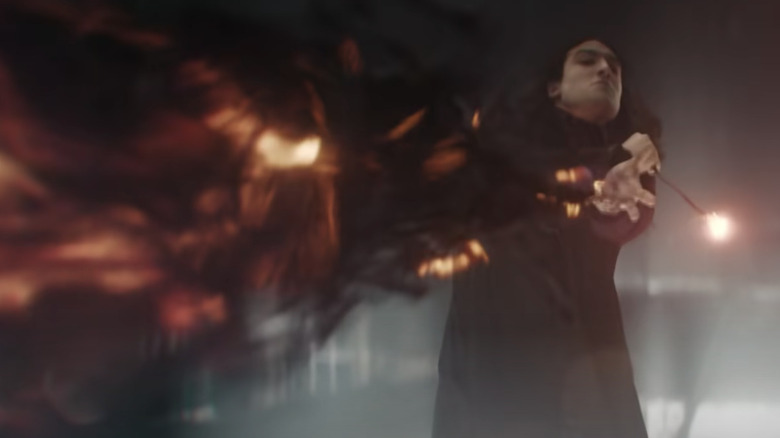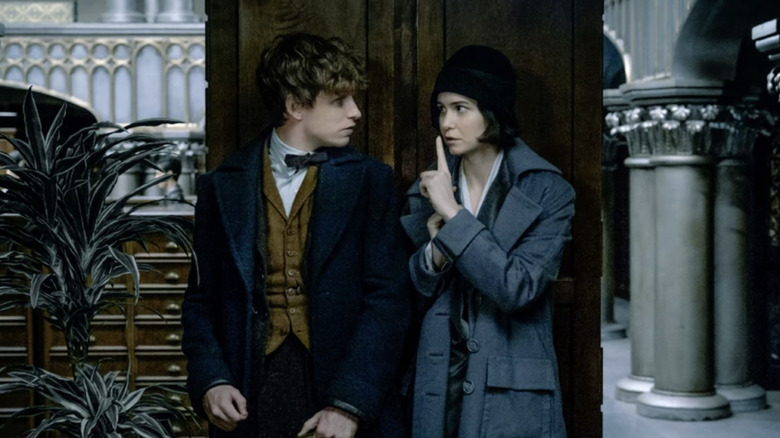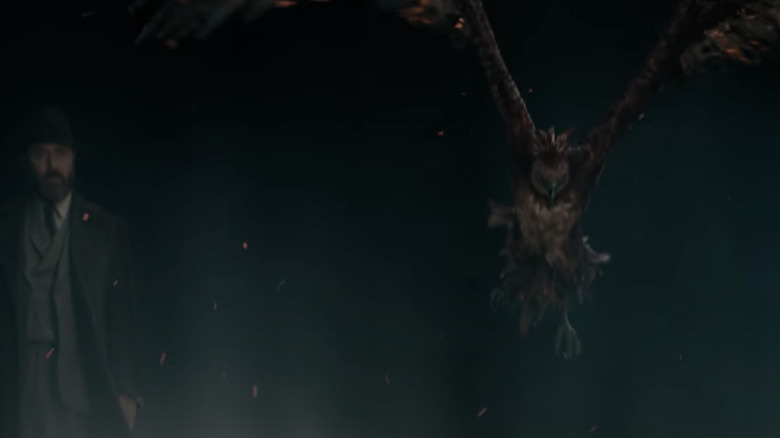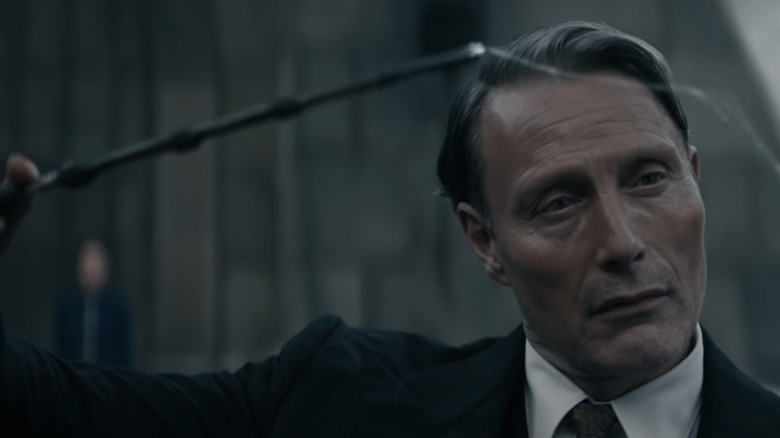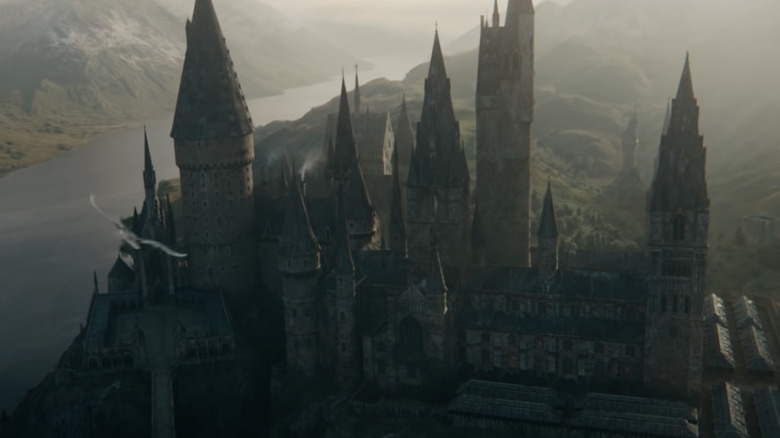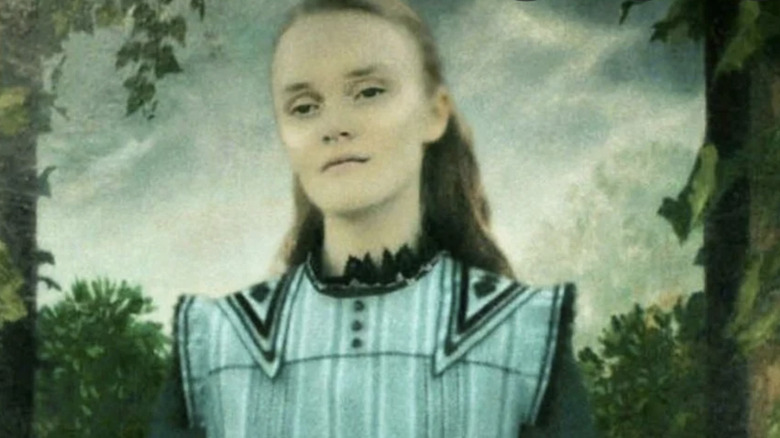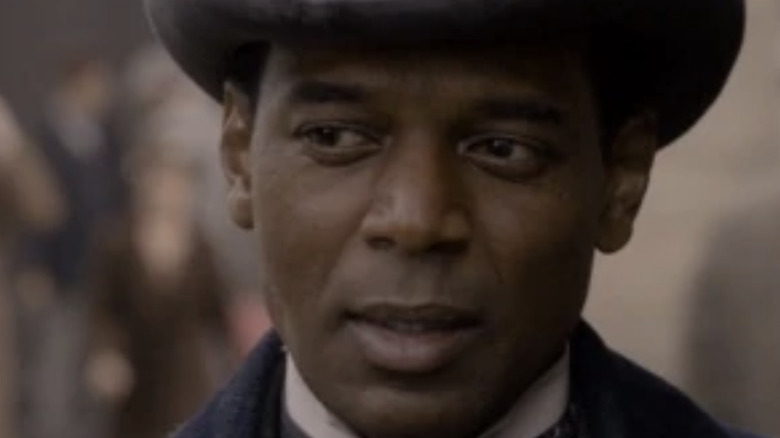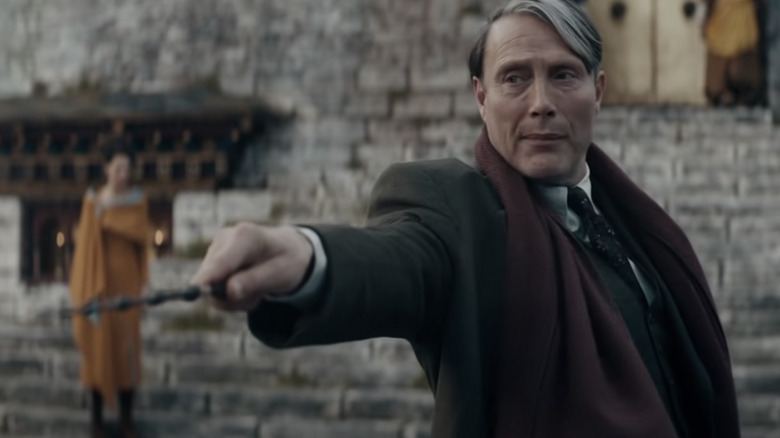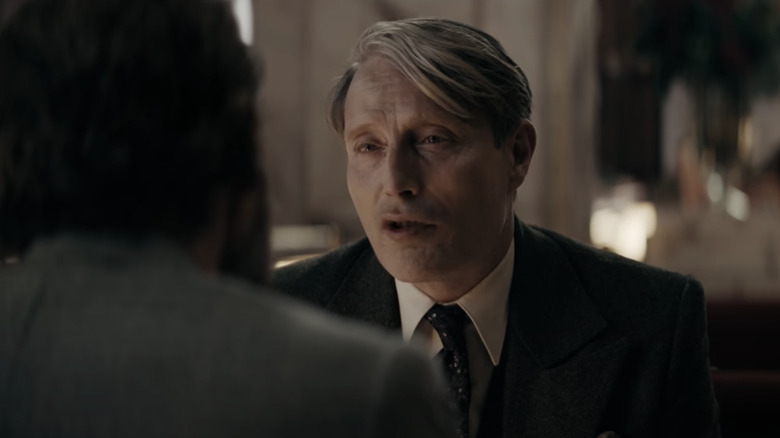Biggest Unanswered Questions From Fantastic Beasts: The Secrets Of Dumbledore
"Fantastic Beasts: The Crimes of Grindelwald" gave fans more questions than answers within its muddled plot. Bouncing back, "Fantastic Beasts: The Secrets of Dumbledore" takes what was great about the "Harry Potter" tales, leans into the "Fantastic Beasts" universe, and the result is a more cohesive, entertaining film. Questions that have plagued fans for years, like 'Will Dumbledore finally address his love for Grindelwald?' are finally answered, as is Credence's lineage. Of course, there are still more films to go, so this installment of the "Fantastic Beasts" series leave some plotlines open-ended for future installments.
Though many characters' motivations become clear throughout the film, some are still holding onto their secrets — even Dumbledore and especially Grindelwald. Meanwhile, characters like Nagini are entirely absent from the film, as are locations like Ilvermorny that have been minimally referenced but missing from the series thus far. Between questions fans have wondered about for years, introduced moments that seemingly contradict previous canon, and new concepts that offer more questions than answers, here's the (spoiler-heavy) things fans are still wondering after watching "The Secrets of Dumbledore."
Who is Credence's mother?
Well, the phoenix is out of the bag now. Credence, also known as Aurelius, is Aberforth's son. But although Albus and Aberforth clued Credence in on his paternal lineage, who exactly is his mother?
There's a good chance she's someone we haven't heard of before, but given Dumbledore's assertion that Aberforth met her "the summer Gellert and I fell in love," she likely lived in Godric's Hollow. Dumbledore confirms that Aberforth fell in love with a girl from the Hollow, noting that she was sent away and there were rumors about a child.
If that name is ringing some Hogwarts bells, it's the same wizarding village where Harry Potter, Dumbledore, and a host of other well-known wizards grew up. The village is home to some of the most notorious wizard names in Britain, so chances are, he comes from a line we might recognize on both ends of his immediate family tree. The village is named after Hogwarts co-founder Godric Gryffindor, after all.
What's going on with Tina and Newt?
Ever since 2016's "Fantastic Beasts and Where to Find Them," Newt and Tina have been the franchise's greatest "Will they? Won't they?" love story in the series. Of course, that's mostly because Grindelwald and Dumbledore are long past their expiration date as a couple (which tends to happen when your lover becomes a dictator). Fans hoping for some bonafide Newtina content will be sadly disappointed, as Katherine Waterston is barely in the film. She gets some random reaction shots during a few of the movie's most pivotal moments, but not much more.
Luckily, Tina doesn't miss her own sister's wedding to Jacob at the end of the film, but even here, there's not much to satiate Newtina fans until (hopefully) the next movie. The pair have an awkward reunion that further implies interest on both ends, but neither initiates a conversation to "define the relationship."
Given how awkward both characters can be, Jacob and Queenie may have to give the duo a push to do something about their obvious feelings for each other, because it's looking less and less likely that they'll get there on their own. However, it's no secret that both characters are into each other. Most people don't look longingly at an ever-present picture of their platonic friend in their briefcase. But until Newt and Tina get it together, fans will have to wait to see the couple actually ... couple.
Is Credence's phoenix Fawkes?
For a movie titled "The Secrets of Dumbledore," the wizard sure is continuing to hold quite a few more close to his impeccably ironed vest. In "The Crimes of Grindelwald," we learn that phoenixes are directly tied to the Dumbledore line. Yet "Secrets of Dumbledore" reveals that the mythical birds only appear when a Dumbledore is close to death. This new piece of family trivia means that Credence is not long for this world, and probably won't make it through the next film.
However, it also begs a question: Is Credence's phoenix actually Fawkes from the "Harry Potter" books/films? If so, how does Dumbledore gain possession of the phoenix? If Credence isn't Fawkes, the question remains — how did Dumbledore gain ownership of a phoenix if he wasn't close to death? After Dumbledore dies in the sixth film, Fawkes sings his lament and then bounces, despite Dumbledore's brother Aberforth living next door to Hogwarts in Hogsmeade. If a phoenix comes when a family member is dying and then remains with a family member after their death, Fawkes would have gone to live with Aberforth, making Dumbledore's later possession of Fawkes confusing.
Some of the most significant flaws in the "Fantastic Beasts" series comes from continuity issues with the "Harry Potter" films/books, as is often the case with prequels. Based on the new lore presented in "Secrets of Dumbledore," it seems like no matter which route the series takes from here, something isn't going to add up to Dumbledore's long possession of Fawkes in the future — whether Credence's bird is indeed Fawkes or not.
What happened with Grindelwald's Hallows obsession?
In the "The Deathly Hallows" book and movies, we learn about Grindelwald's quest for the Deathly Hallows, as well as his tagline: "For the greater good." Though the "Fantastic Beasts" films chronicle Grindelwald's rise to power, we don't hear much about his quest for the Hallows. The only reference to Grindelwald's obsession with the Three Brothers' wares is Grindelwald's wand — which fans will notice is the Elder Wand that Dumbledore uses throughout the "Harry Potter" series.
We know that Grindelwald took the wand from the famed wandmaker Gregorovitch, which he must have done sometime prior to the start of "The Crimes of Grindelwald." Yet the series, which fans expected to be, in part, a quest for the Hallows, has barely even touched on that aspect of Dumbledore and Grindelwald's obsession. Sure, Grindelwald has bigger fish to fry, but Xenophilius Lovegood makes the Hallows out to be much more relevant to Grindelwald's rise to power than we've seen in the movies thus far.
Given that Grindelwald wasn't exactly a household name when he was cruising for the Hallows with Dumbledore and graffitiing the Hallows symbol on Durmstrang walls, it's surprising that this aspect of Grindelwald's rise would be such a central focus after his fall, unless it comes up more significantly later. So, what's up with Grindelwald's Hallows obsession? The only other reference we've seen so far is the small Hallows symbol within Grindelwald's power symbol that erupts in fireworks when he steals the election — akin to Voldemort's Dark Mark symbol.
What does Ilvermorny look like?
Hogwarts welcomes fans back home in "The Secrets of Dumbledore" for the second time in the prequel series. However, we know that Hogwarts isn't the only wizarding school around. Given that a good chunk of the "Fantastic Beasts" main characters hail from the U.S., we're missing out on the history and aesthetic of an entirely new wizarding school that we haven't yet seen. While J.K. Rowling got slammed for the problematic Native American appropriation that Ilvermorny had when she posted its background to Pottermore (Salon), the series is her chance to right some of those wrongs.
We're three movies in now, and still have little to no information on the American wizarding school. Of course, viewers might not be missing much, judging from the bizarre, mildly cringey deleted scene from the first film when Queenie and Tina sing Ilvermorny's school song. Yet, beyond the animated video that Warner Bros. released during the build-up to the first "Fantastic Beasts," the school is barely mentioned — let alone depicted in any meaningful way.
And sure, it's always wonderfully nostalgic to go back to Hogwarts, but the beauty of "Fantastic Beasts" lies in a worldwide glimpse of the wizarding world that doesn't just exist within the walls of the castle. Fans want to experience other staples of this world. Grindelwald caused a whole lot of mischief at Durmstrang during his tenure, and we have yet to see the German school grace our screens, either. Obviously, Hogwarts models already exist, making it cheaper and easier — but fans want more world building that we haven't yet scene.
What really happened with Ariana?
One of the greatest mysteries that fans have pondered since the original "Harry Potter" series revolves around which spell killed Ariana Dumbledore when a duel broke out between Albus, Aberforth, and Grindelwald. Of course, Dumbledore himself doesn't know the answer, unless he was lying to Harry all those years later. However, Aberforth's refusal to broach the subject when Albus brings up Ariana in "The Secrets of Dumbledore" hints that Aberforth might know more than he's letting on.
Could Aberforth have iced out his brother because he himself killed Ariana and, wracked with guilt, he blames Dumbledore? Or was it Albus himself or his lover Grindelwald? No matter which way you spin it, Aberforth blames Dumbledore for wanting to leave and causing the duel. There's also one disturbing element to the story that Albus reveals in the new film: Grindelwald laughed when Ariana came downstairs as Aberforth and Albus dueled. Knowing that Aberforth disapproved of Albus leaving, and knowing Albus would have a hard time abandoning his sister, it's entirely possible that Grindelwald intentionally killed Ariana to take away Albus' singular reason to stay.
During the film, Dumbledore also reveals another crucial detail: Ariana was, in fact, an obscurial who couldn't express her magic. We know that she gave up magic at a young age, but this, paired with the knowledge that obscurial children rarely make it to 18, hints that Ariana was already dying when the spell killed her. Grindelwald demonstrates his coldblooded murderous tendencies in "Secrets of Dumbledore" when he loses the election. So his "For the greater good" tagline would certainly absolve him of Ariana's murder in his own mind — especially if she were already dying. So, whose spell killed Ariana? We may never know.
How does Yousuf hoodwink Grindelwald?
Just when we thought Yousuf joined Grindelwald's ranks of hoodwinked witches and wizards, the wizard surprises audiences by popping up at the end of the film to rejoin the good fight. Yousuf is somewhat of a closed book, and his motivations in "The Crimes of Grindelwald" were pretty dicey to begin with. Granted, it's not Yousuf's fault that his father forced him into a murderous, unbreakable vow to kill his sister — and that's a pretty messed up thing to put on a child. The only reason he doesn't kill Leta is that her father never loved her (yikes), making revenge impossible.
All in all, a lot is going on here, but in the end, Yousuf does seem to care about Leta — so much so that her death racks him with guilt and Grindelwald opts to take away his memories of her. Messing with memories is tricky business. Not only is Yousuf giving Grindelwald full access to his memories, but he's making his mind vulnerable to him.
It's clear that Grindelwald wanted Queenie to join his ranks because she's a powerful Legilimens. However, the fact that Yousuf is able to hoodwink Grindelwald at all means he has some profound skills in Occlumency and possibly even has some Legilimency skills himself. So what exactly are Grindelwald's skills involving the mind, what are Yousuf's true motivations, and how exactly does Yousuf manage to keep his betrayal a secret from Grindelwald when the guy is actively rooting around in his memories?
Did Grindelwald ever love Dumbledore?
Throughout the film, Dumbledore not only mentions that he fell in love with Grindelwald, but he even remarks, "The summer Gellert and I fell in love." Dumbledore's statement implies that, at the very least, their romance wasn't one-sided. However, to what extent is Grindelwald even capable of true, unselfish love — and how much of his romance with Dumbledore hinged on manipulating his lover for his own ends?
Several times in "The Secrets of Dumbledore," Grindelwald uses Dumbledore's love against him. Not only does he say, "Who will love you now?" when their blood troth breaks, he also remarks, "I was never your enemy ... then." Grindelwald uses both comments to taunt and break Dumbledore's heart, who is clearly still carrying a torch for his former flame. Yet, as Grindelwald declares war on Dumbledore while claiming they weren't enemies until this moment, he's keeping the fact that he ordered Credence to kill Albus to himself.
We know that Dumbledore eventually takes down Grindelwald alive, but it's pretty obvious that killing Dumbledore is a necessity for Grindelwald rather than a last resort. While Dumbledore still cares about Grindelwald and his wellbeing, it's unclear whether or not Grindelwald ever put Dumbledore's needs above his own — a hallmark of love. Compared to Voldemort, it certainly seems that Grindelwald, at the very least, is capable of affection and emotion. But at the end of the day, he seems to choose power over love.
The evidence will play out in their final battle, but as of now, Grindelwald's capability for love is a mystery. One hint we do have comes much later in Grindelwald's life, after he'd been rotting in Nurmengard for fifty years. The dark wizard refused to tell Voldemort who possessed the Elder wand, perhaps, as Harry mused, to keep him from desecrating Dumbledore's tomb — or to stop Voldemort from obtaining it to honor his fallen lover.
Who was on Grindelwald's chopping block?
Grindelwald's true, unfiltered and impulsive rage rears its head for the first time in "The Secrets of Dumbledore." Of course, we see glimpses of his rage bubbled beneath the surface throughout the first two films, but it's encased in a layer of charm and manipulation. Yet you can't keep a dictator from publicly showing their colors for too long, and he displays who he really is to the entire wizarding world when he casts Avada Kedavra at ... someone?
Vicência Santos has just won the title of Supreme Mugwump after Dumbledore's first Army foiled Grindelwald's deceptive plan. It appears that Grindelwald aims his spell at Vicência in a very "If I can't have it, nobody can" type of way. Yet fans can't be entirely sure, as his spell meets with Dumbledore's right in front of Credence seconds after casting. In Grindelwald's mind, he has just as much reason — and maybe more — to be enraged with Credence.
After all, the obscurial has failed almost every mission Grindelwald tasked him with throughout this film. Killing Dumbledore? Failure. Capturing the Qilin? Failure. And that's on top of Credence's public condemnation of his former overlord. Sufficed to say, Grindelwald is angry, and it's not abundantly clear who elicited the killing curse from the Elder Wand. Let's face it: If Credence and Vicência were standing closer, he would probably try to take them both out in one go.
